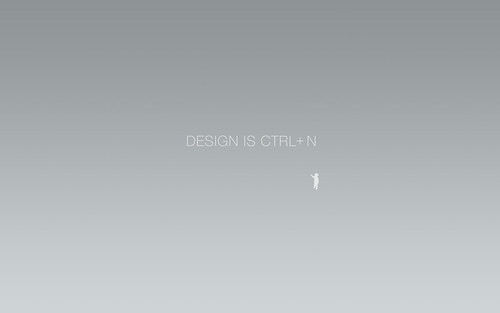Note: At the suggestion of Andrew Krzmarzick, I am crossposting from my personal blog.
A thought stewed in the slow cooker of my brain for several weeks, which finally reduced to a tasty idea in the wake of the COINs 2010 conference: It is difficult to undo (Ctrl-Z). It is often easier to begin anew (Ctrl-N).
I look at software like Photoshop. Photoshop is arguably the most brilliant piece of software ever designed/engineered. It’s extremely complex, very versatile. You can argue Microsoft Word or Excel and for my purposes here, they may also work. My point is that it took years for Photoshop to include the concept of multiple Undo (more than just the last action). Even in the most recent version of Photoshop I touched, you had to set the limit for how many layers of Undo it would have to track. But right from the gate, in the very first version of Photoshop, if you got far enough into a project that you realized that something was majorly screwed up, you could always create a new Project and start anew.
If you or someone you know has participated in some kind of cognitive behavior therapy, no doubt there’s some digging deep into the inner-child. To essentially address issues that deep, where layers and layers of belief systems have been built on top of this footing, there is a lot to undo and then (not unlike a multiple undo in Photoshop), a lot to re-do. Sometimes it’s easier to replace bad patterns with new patterns — basically doing a Ctrl-N. Militaries do this in basic training all the time, where they disrupt existing attitudes, belief systems and behavior patterns with new ones. Many lifestyle programs like Weight Watchers focus on helping you to reinforce new patterns of behavior, new lifestyle choices, etc.
Weight Watchers is especially interesting because it’s a good example of how Undoing and New, in the context of lifestyle choices and behavior patterns, is not quite a binary option among two extreme positions. While the program reinforces new behavioral patterns, it is also demanding reflective practice so that you fully embody the changes taking place.
Embodied Change = Learning. Learning is evidenced by change.
My point brings me back to the notion of General Semantics, which I blogged a little bit about yesterday. Over time, ideas and behavior patterns we grow increasingly dependent on become maxims — fixed structures — which we often take for granted as being true. Instead of ideas and patterns being useful tools to help us perform better in a given context, we have a tendency to let them take root and become a structure by which we continue to see the world, even though the world itself changes (and thus, the context changes).
When this happens, we tend to bend our understanding of the world to fit with the fixed mental frames we invented, rather than those ideas and patterns adjusting to accomplish the goals for which they had purpose.
The wicked problem that we must tackle in the changing business of learning is “Awareness.” It is the same problem that must be tackled in health care, in energy, in sustainability… the more and more we connect with each other and to information sources, the more we individually define what our own knowledge spaces are. The challenge is that we don’t know what we don’t know — and we generally discard stuff we think doesn’t apply to us. We must continue to find ways to be open to what seems to be new and completely disconnected information and find ways to absorb it and make sense of it. We must force ourselves to change.
We can try and accept new, disruptive information by undoing years and years of habituated filtering out of this kind of information (scarcity); at the same time, we can embrace a new pattern of trying to accept all manner of information and allowing learning to take us where it will (abundance).
Ctrl-Z and Ctrl-N.





Great post, Aaron. Very insightful to make a mash-up of “undo” and “new”…
Thanks a lot, Monica!
On Twitter, someone (@eestes) asked me if I thought Apple was an example of doing a lot of Ctrl-N, and I think they do it very well. They don’t (at least not in any example I can recall) ever ask us to reframe who they are or what their products do, they simply introduce new message and memes and re-assert them over and over again. Microsoft looks to reinvent itself (Ctrl-Z) in the consumer space and I think it’s much harder for a whole lot of reasons.
That wasn’t the goal of what I was trying to point out, but I can see this pattern thinking in lots of contexts. I’m glad you liked the post, Monica!
Apple and Microsoft is a very interesting example. I think where Microsoft hurts is because they are still a successful model so it’s hard to just hit Ctrl-N when you are still making money hand over fist so you instead try to tweak. It’s all about having the attitude of great success or spectacular failure and not settling for anything in between.
Stephen, you raise a very good point, which along with a conversation I had on Twitter yesterday led me to a whole new blog post on how the thinking that “If it ain’t broke, don’t fix it” is fundamentally flawed.